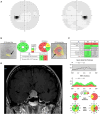Sellar masses: diagnosis and treatment
- PMID: 38983521
- PMCID: PMC11182331
- DOI: 10.3389/fopht.2022.970580
Sellar masses: diagnosis and treatment
Abstract
Sellar mases can cause a variety of neuro-ophthalmic manifestations, including compressive optic neuropathy, chiasmal syndrome, and ophthalmoplegia due to cranial nerve palsy. Diagnosis involves a thorough history, neuro-ophthalmic examination, and ancillary tests and investigations. Visual field testing is critical in diagnosing and localizing the lesion and determining the extent of visual field loss. Appropriate neuro-imaging is essential in characterizing and localizing the lesion. Neuro-ophthalmologic assessment include meticulous clinical examination and ancillary tests including,visual field testing, which is useful in localizing the lesion, and optical coherence tomography, which is helpful in assessing the degree of axonal and neuronal loss and predicting the visual outcome. Treatment requires a multidisciplinary approach by different specialties, including radiologists, neuro-ophthalmologists, and neurosurgeons. The two primary treatment modalities for these tumors are surgery and radiation therapy. We review the main types of sellar lesions, their neuro-ophthalmologic evaluation, and treatment options.
Keywords: compressive optic neuropathy; craniopharingioma; ganglion cell complex (GCC); meningioma; optical coherance tomography; pituary adenoma; sellar masses.
Copyright © 2022 Al-Bader, Hasan and Behbehani.
Conflict of interest statement
The authors declare that the research was conducted in the absence of any commercial or financial relationships that could be construed as a potential conflict of interest.
Figures






References
Publication types
LinkOut - more resources
Full Text Sources

